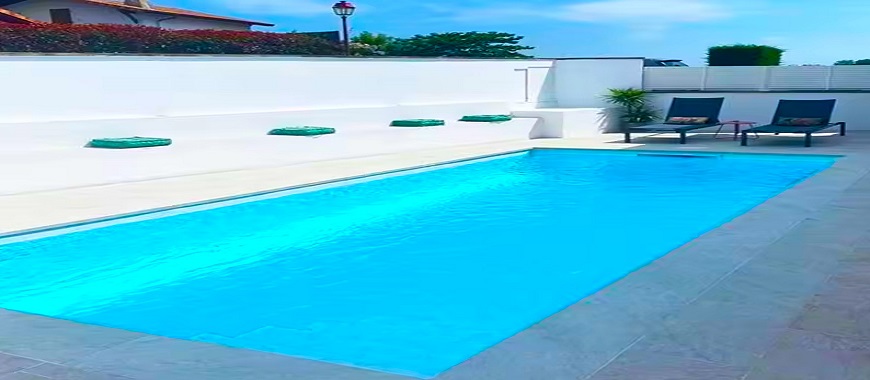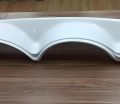
When deciding between thermoplastic vs fiberglass tub wall materials for your bathroom renovation, it’s important to consider durability, maintenance, and cost. Thermoplastic tub walls are known for their flexibility and strength, making them resistant to cracking and breaking under pressure. They are also lightweight and easy to install, offering a smooth, modern appearance. On the other hand, fiberglass tub walls are highly affordable and offer great resistance to mold and mildew. While fiberglass is lightweight and cost-effective, it is more prone to scratches and discoloration over time. Both materials are relatively easy to clean, but thermoplastic vs fiberglass tub wall offers distinct advantages depending on your budget and long-term needs.
How Thermoplastiv Vs Fiberglass Tub Wall Influences Bathroom Design
Choosing between thermoplastic vs fiberglass tub wall is a critical decision for homeowners looking to balance practicality, aesthetics, and cost-effectiveness. Both materials are widely used in bathroom design, but their unique properties cater to different needs and preferences. Understanding the specific characteristics of each can help you select the option that aligns best with your goals for durability, maintenance, and style.
Fiberglass is often seen as an economical choice, making it appealing for homeowners working within tight budgets or seeking functional solutions for guest or rental properties. Its lightweight nature and ease of installation add to its appeal. However, thermoplastic has emerged as a modern alternative, offering enhanced durability, a more polished look, and greater customization options. With its smooth, resilient surface, thermoplastic delivers a sleek, high-end feel that suits contemporary bathroom aesthetics.
The decision between thermoplastic vs fiberglass tub wall also involves considering long-term performance and maintenance. While fiberglass requires consistent care to avoid scratches and discoloration, thermoplastic is engineered to resist wear and tear over time. This makes it a preferable choice for high-traffic bathrooms or households with children where durability is a priority. Ultimately, the right choice will depend on your lifestyle, budget, and vision for your bathroom space.
Durability and Maintenance: Thermoplastic vs Fiberglass Tub Wall
Resilience of Thermoplastic in Everyday Use
Thermoplastic tub walls are designed to withstand heavy use without compromising their structural integrity or appearance. Unlike fiberglass, which can crack or chip under stress, thermoplastic offers a tougher surface that resists impact and damage. This makes it particularly suitable for families or homes with frequent bathroom usage, where reliability is essential.
Thermoplastic’s resistance to moisture and humidity also makes it ideal for bathrooms. It doesn’t absorb water, reducing the risk of mold or mildew growth. This feature not only enhances its longevity but also contributes to a cleaner, healthier bathroom environment.
Fiberglass’s Susceptibility to Wear
While fiberglass is durable in its own right, it is more vulnerable to surface damage than thermoplastic. Scratches and stains can develop over time, especially with frequent use. Fiberglass is also more porous, which makes it prone to discoloration and soap scum buildup if not cleaned regularly. These drawbacks mean that fiberglass tub walls often require more maintenance to keep them looking their best.
Fiberglass may also be less forgiving when accidents happen. Dropping a heavy object, for example, can cause cracks that compromise the tub wall’s waterproofing. Repairs to fiberglass, while possible, may not fully restore its original appearance, leaving visible patches or seams.
Long-Term Maintenance Effort
Thermoplastic requires minimal upkeep compared to fiberglass. Cleaning thermoplastic tub walls typically involves wiping them down with a damp cloth or using a mild detergent, whereas fiberglass may require stronger cleaning products and more frequent attention. Over time, the ease of maintaining thermoplastic surfaces adds up, saving effort and reducing the need for costly repairs or replacements.
Common Use Cases
In bathrooms with heavy traffic, such as those in larger families or shared spaces, thermoplastic tub walls provide the durability needed to withstand constant use. For less frequently used areas, such as guest bathrooms, fiberglass can still offer a cost-effective and functional solution. These distinctions highlight how thermoplastic vs fiberglass tub wall options cater to different needs.
Aesthetic Considerations: Thermoplastic vs Fiberglass Tub Walls
Sleek and Modern Appeal of Thermoplastic
Thermoplastic tub walls excel in delivering a clean, contemporary look. Their smooth finish and broad range of colors and textures allow homeowners to achieve a high-end aesthetic. This versatility extends to custom shapes and designs, enabling thermoplastic to adapt to unique bathroom layouts or personalized styles.
Homeowners seeking to create a spa-like atmosphere often favor thermoplastic for its ability to mimic luxurious materials like stone or tile. This material’s flexibility in design means that it can complement virtually any bathroom theme, from minimalist to industrial to eclectic.
Traditional Charm of Fiberglass
Fiberglass tub walls, on the other hand, are more suited to traditional or classic bathroom designs. Their glossy finish and neutral tones work well in straightforward layouts where simplicity is key. While fiberglass doesn’t offer the same level of customization as thermoplastic, its understated look can be appealing for those who prefer a more conventional style.
Fiberglass also tends to be associated with a more functional aesthetic, prioritizing utility over appearance. This makes it a practical choice for budget-conscious projects or spaces where visual impact is not the primary concern.
Enhancing Bathroom Atmosphere
The choice between thermoplastic vs fiberglass tub wall can significantly influence the overall ambiance of a bathroom. Thermoplastic’s premium feel can elevate the space, creating a sense of sophistication and refinement. Fiberglass, while less striking, provides a reliable and approachable backdrop for everyday use.
The ability of thermoplastic to be molded into intricate patterns or embossed designs also makes it a standout choice for homeowners looking to add unique visual elements to their bathroom. This creative potential further distinguishes it from fiberglass, which is generally limited in design scope.
Why the Debate Matters: Thermoplastiv Vs Fiberglass Tub Wall
The choice between thermoplastic vs fiberglass tub wall is more than a matter of cost or durability—it’s a decision that shapes the look, feel, and functionality of one of the most important rooms in your home. Bathrooms are spaces of daily use and relaxation, and the materials you select for your tub walls play a pivotal role in ensuring comfort and satisfaction.
For those seeking a high-end aesthetic with minimal maintenance, thermoplastic emerges as the superior choice. Its combination of resilience, design flexibility, and environmental benefits makes it ideal for modern bathrooms. However, fiberglass continues to serve as a reliable, budget-friendly alternative for less demanding settings.
By carefully weighing the unique benefits and limitations of thermoplastic vs fiberglass tub wall materials, homeowners can make informed choices that enhance their bathroom’s utility and appeal. Whether prioritizing durability, customization, or affordability, there’s a solution to suit every need.
Practical Factors in Thermoplastic vs Fiberglass Tub Wall
Installation Convenience
Both thermoplastic and fiberglass are lightweight and relatively easy to install compared to heavier materials like ceramic or stone. However, thermoplastic has a slight edge due to its flexibility, which allows for easier handling and fitting into irregular spaces. This can make thermoplastic tub walls a more convenient choice for DIY projects or renovations with tight timelines.
Cost Implications
Fiberglass is often the more affordable option upfront, making it a go-to material for budget-conscious homeowners. Its lower cost, however, can be offset by higher maintenance needs and a shorter lifespan compared to thermoplastic. For those planning to stay in their homes long-term, investing in thermoplastic may prove more cost-effective over time.
Environmental Considerations
Thermoplastic is often more eco-friendly due to its recyclability and longer lifespan, reducing waste over time. Fiberglass, while less environmentally sustainable, remains a popular choice for projects where affordability takes precedence over environmental impact.
Customization Potential
For bathrooms requiring unique designs or layouts, thermoplastic offers far greater customization potential. Its ability to be molded into complex shapes and patterns means that homeowners can achieve highly personalized results, something that fiberglass cannot match as effectively.
Fiberglass Extruded Tube: Key Benefits and Applications Explained
How Thermoplastiv Vs Fiberglass Tub Wall Impacts Your Bathroom Choice
Choosing between thermoplastic vs fiberglass tub wall is a significant decision that affects the aesthetics, durability, and functionality of your bathroom. These two materials are among the most popular options for tub walls, each offering unique advantages and drawbacks. While thermoplastic tub walls are known for their modern appearance and long-lasting performance, fiberglass stands out for its affordability and ease of installation.
The material of your tub wall doesn’t just influence the look of your bathroom—it also impacts how much time and effort you’ll spend on maintenance, how well the tub withstands everyday use, and how long it will last before needing replacement or repairs. Thermoplastic vs fiberglass tub wall considerations are not just about choosing a material but about aligning the choice with your lifestyle, budget, and personal preferences.
Fiberglass walls, though practical and budget-friendly, often require more upkeep over time. On the other hand, thermoplastic walls provide enhanced resistance to damage and discoloration, making them a more durable option for high-traffic bathrooms. Understanding the differences between these materials is crucial for making an informed decision.
Durability: Thermoplastic vs Fiberglass Tub Wall
Resilience and Longevity of Thermoplastic
Thermoplastic tub walls are engineered to handle the wear and tear of daily use with remarkable durability. Their flexibility and strength make them resistant to cracking, even when subjected to impacts. This resilience is particularly beneficial in family homes, where bathroom fixtures experience frequent use and occasional mishandling.
Thermoplastic’s non-porous surface is another critical advantage. It doesn’t absorb water, which means it’s highly resistant to mold and mildew—a common concern in humid bathroom environments. This property not only preserves the structural integrity of the walls but also contributes to a healthier and cleaner bathroom.
Vulnerability of Fiberglass to Wear
Fiberglass tub walls, while durable to an extent, are more prone to surface damage such as scratches and cracks. Over time, these imperfections can compromise the wall’s waterproofing and appearance. Additionally, fiberglass is more likely to discolor when exposed to harsh cleaning agents or constant moisture.
Repairs to fiberglass can be challenging. While small cracks and chips can be patched, the repaired areas often stand out from the rest of the wall. This can detract from the overall look of the bathroom and may lead to the need for complete replacement sooner than expected.
Long-Term Maintenance Efforts
Thermoplastic requires minimal maintenance to retain its finish and durability. A simple wipe-down with soap and water is usually sufficient to keep it looking pristine. In contrast, fiberglass walls demand more frequent cleaning and occasional refinishing to address dullness or discoloration. This difference can be a deciding factor for homeowners who want a low-maintenance solution.
Real-Life Examples of Durability
For families with young children or households where bathrooms are used extensively, thermoplastic tub walls are the superior choice. They can withstand accidental impacts, heavy cleaning, and high humidity without showing signs of wear. Fiberglass might be a suitable option for guest bathrooms or spaces with lighter usage.
Aesthetic Appeal: Thermoplastic vs Fiberglass Tub Wall
Modern Elegance with Thermoplastic
Thermoplastic tub walls are celebrated for their sleek and modern appearance. Available in a wide range of colors, patterns, and textures, thermoplastic allows homeowners to create customized designs that align with their bathroom’s theme. Whether you’re aiming for a minimalist, industrial, or luxurious aesthetic, thermoplastic can meet your needs.
The moldability of thermoplastic is a significant advantage. It can be shaped into intricate patterns or embossed designs, providing a unique visual element that enhances the bathroom’s appeal. This versatility makes thermoplastic an ideal choice for homeowners who want their bathroom to stand out.
Classic Simplicity of Fiberglass
Fiberglass tub walls have a more traditional look, typically featuring smooth, glossy surfaces in neutral colors. While they may lack the design flexibility of thermoplastic, their simplicity can work well in classic or understated bathroom designs. Fiberglass is often the go-to option for those seeking a functional and clean appearance without breaking the bank.
Matching Bathroom Décor
Thermoplastic’s wide variety of finishes makes it easy to match with other bathroom fixtures, such as countertops, cabinets, and flooring. Its ability to mimic the appearance of high-end materials like stone or marble further enhances its adaptability. Fiberglass, while more limited in design options, can still complement basic bathroom layouts where functionality is prioritized.
Longevity of Visual Appeal
Thermoplastic tub walls retain their color and finish over time, even with frequent exposure to water and cleaning agents. This ensures that your bathroom maintains a polished and fresh look for years. Fiberglass walls, in comparison, may develop dull spots or discoloration, requiring more effort to maintain their original appearance.
Top Benefits of Choosing a Fiberglass Oval Tub
Why Thermoplastiv Vs Fiberglass Tub Wall Matters
Choosing between thermoplastic vs fiberglass tub wall is about more than just selecting a material—it’s about creating a bathroom that suits your lifestyle and enhances your home’s value. Thermoplastic offers unparalleled durability, aesthetic versatility, and low maintenance, making it a top choice for modern and high-use bathrooms. Fiberglass, while less durable, provides an affordable and functional solution for spaces with lighter usage.
The decision ultimately comes down to your priorities. If you value long-term performance and customization, thermoplastic tub walls are the way to go. For cost-sensitive projects where simplicity and functionality are key, fiberglass remains a reliable option. By carefully considering your needs, you can choose the material that transforms your bathroom into a space that’s both practical and visually appealing.
Cost Considerations: Thermoplastic vs Fiberglass Tub Wall
Upfront Costs and Affordability
Fiberglass tub walls are generally more affordable than thermoplastic, making them a popular choice for budget-conscious homeowners or those renovating multiple bathrooms. This cost advantage makes fiberglass especially appealing for rental properties or temporary solutions.
Long-Term Value of Thermoplastic
While thermoplastic tub walls may have a higher initial cost, their durability and low maintenance requirements make them a cost-effective choice in the long run. By reducing the need for repairs, refinishing, or replacement, thermoplastic can save homeowners money over time.
Installation Costs
Both materials are lightweight and relatively easy to install, but thermoplastic’s flexibility simplifies the process, especially in irregularly shaped bathrooms. This can lead to reduced labor costs, particularly for DIY installations. Fiberglass, while also easy to install, may require more care to avoid damage during the process.
Balancing Budget with Features
For homeowners seeking a balance between cost and features, fiberglass is a viable option for guest bathrooms or secondary spaces. However, for primary bathrooms where durability and aesthetics are critical, thermoplastic is worth the investment.
Examples of Cost Scenarios
A family renovating a master bathroom for long-term use might opt for thermoplastic due to its lasting benefits. On the other hand, a landlord outfitting rental units might choose fiberglass to minimize upfront expenses while still providing functional tub walls.
Why Choose a Fiberglass Pedestal Tub for Bathrooms?
FAQs about Thermoplastiv Vs Fiberglass Tub Wall
The best bathtub material depends on your needs and preferences. For durability and ease of maintenance, acrylic and fiberglass are popular choices. Acrylic bathtubs are lightweight, resistant to scratches, and retain heat well. They also come in a variety of colors and styles. Fiberglass, on the other hand, is more affordable, but it can be prone to scratching and may require more maintenance. For those seeking luxury, cast iron and stone bathtubs are durable, long-lasting, and provide excellent heat retention but come at a higher price. If you’re looking for a bathtub that’s easy to clean and maintain, acrylic is a great option, while fiberglass offers a budget-friendly alternative with more flexibility in design.
Both acrylic and fiberglass bathtubs have their pros and cons, and the choice ultimately depends on your preferences and budget. Acrylic bathtubs are generally more durable, resistant to scratches, and better at retaining heat. They also come in a wider range of colors and designs. Fiberglass, while more affordable, is lighter but can scratch more easily and may show wear over time. However, fiberglass tubs are still a good option for those on a budget, and they’re easier to install due to their lighter weight. Acrylic tubs tend to last longer and provide a smoother, more luxurious finish, making them the better choice if you’re looking for durability and a sleek appearance.
If heat retention is a priority for you, cast iron and stone bathtubs are your best bet. These materials are excellent at holding heat, making them perfect for long, relaxing baths. Cast iron, in particular, has a thick enamel coating that retains heat for an extended period, keeping the water warm longer. Acrylic and fiberglass bathtubs are less effective at heat retention, although some high-end models feature thicker layers of insulation to help improve this. If you want to maintain a warm bath for longer periods, consider investing in a bathtub with superior insulating properties like cast iron, which will provide the best thermal efficiency.

As the editor of GangLong Fiberglass, I have years of experience and in-depth research, focusing on cable tray products, fiberglass solutions, and grille systems. I incorporate years of industry insights and practical experience into every content, committed to promoting the progress of the industry. At GangLong Fiberglass, my commitment is reflected in every product, from innovative cable trays to durable fiberglass solutions and sturdy grille systems. As an authoritative voice in the industry, my goal is to provide valuable information to professionals and businesses and promote forward-looking solutions.


